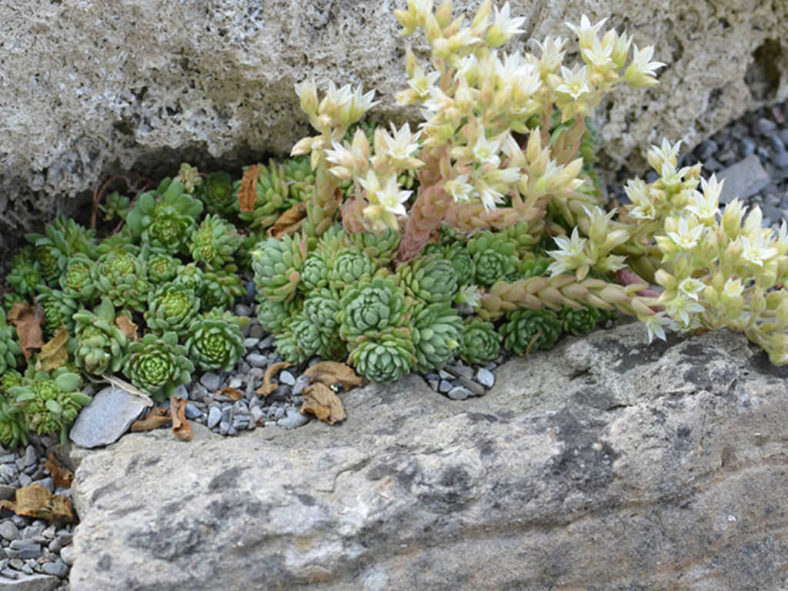Rosularia is a genus of rosette-forming succulents in the family Crassulaceae. They resemble other rosette-forming succulents from the same family, such as Sempervivum and Echeveria, although they are more closely related to Sedum.
The leaves of the plants range in color from glaucus green to a lovely dusky rose. The margins may be lined with tiny hairs called cilia or a contrasting color to the rest of the leaves. The leaves will be brighter in summer when the natural light is brighter. Rosularias tend to have small rosettes and beautiful funnel or tube-shaped flowers that grow on tall inflorescences, usually from the center of the rosettes, and range in color from white and yellow to bright pink and purple and may be striped. The rosettes will not die after flowering. Rosularias bloom in late spring.
Like Sempervivum, Rosularias are cold-tolerant alpine succulents found natively in the mountains and hills of Turkey, Cyprus, North Africa, and Asia. These plants are fairly hardy but are hard-to-find in cultivation.
Rosularias will propagate themselves by forming offsets, also called "pups." Some species are more prolific than others. In cultivation, the grower would propagate Rosularia using leaf cuttings or separation of offsets.
Growing Conditions
Light: Full sun is ideal in environments that are not too hot, but partial shade is satisfactory for most species. When grown in a tropical climate, these plants should not be placed in full sun, or the plant will scorch and die.
Temperature: Like Sempervivum, Rosularia will tolerate cold. These plants can withstand temperatures as low as -10°F to 0°F (-23°C to -17°C).
Water: Potted Rosularia should be watered when the soil is moderately dry. Allow the soil to dry out to a depth of 1 inch (2.5 cm) before watering, and avoid getting water on the leaves. The plants will require less water in winter, as reduced temperature and humidity will induce dormancy. If you are unsure when to water your Rosularia, watch the lowermost leaves for drying signs and water them then.
Soil: Rosularias can tolerate poor soil conditions so long as it is well-draining.
Fertilizer: During the growing season, feed with fertilizer for succulents. Suspend feeding during the dormant winter period.

Propagation
The plants self-propagate through offshoots; given time, one plant will form a dense mat of many. However, it is more common for the grower to use offset separation or leaf-cutting methods in cultivation. To separate an offset, remove soil from the offset's base to find the stolon (a thick root that attaches the pup to the mother plant). It is best to use an offset that has already established some roots. Cut the stolon close to the offset (to discourage the roots from growing from the stolon). Place the offset into a small pot with well-draining soil. Do not water until new growth is noted.
Leaf-cutting entails cutting a young leaf from near the center of the rosette. Leave the leaf in the open air for a day to allow the wound to callous. Next, dip the leaf into a rooting hormone and place the leaf (cut-side down) into a slightly moist succulent potting mix (even better, very lightly moist sand). Soon, a new rosette will grow from the base of the leaf. When enough roots are present to repot, remove the original leaf cutting and repot the rosette.
It is best to pot at the start of the active growing season in late winter or early spring.
Pruning
No pruning is necessary except to remove any leaves that have died. This will help to avoid rot and bugs.
Pests and Problems
In the event of an unhealthy plant, the first thing to examine is your watering habits. The most common problem is root rot due to overwatering. If the soil is too wet, do not hope it will safely dry out if you do not water it for a while. Replace the soil immediately, and remove any damaged roots with sharp, sterile scissors or a knife.
One of the most common pests to houseplants is the mealybug, and your Rosularia may fall prey to this pest. However, the mealybugs will often attack the roots due to the tightly packed leaves. This makes them far less visible than mealybugs, which attack leaf-stem junctions. A root mealybug infestation symptoms are slowed or stopped growth (though in summer, this is a normal sign of dormancy). If this occurs without apparent cause, remove the plant from the pot and examine the roots. A white cottony substance on the roots and soil is a sure sign of mealybug infestation. Remove all soil and wash the roots gently. Remove any damaged roots with a sharp, sterile knife or scissors. Let them dry very thoroughly before replanting.
This plant is best grown outdoors, and if you live in an area where winter temperatures rarely go below -10 °F (-23 °C), this is the best for Rosularia. When potted, these plants are very susceptible to vine weevil. The plant is often used as a bedding or groundcover plant.
Grower's Tips
Whether grown outdoors or indoors, these plants are good to forget about. Too much attention will kill the plant. When grown outdoors in a wet environment, ensure the soil is sandy and well-draining. If you are not careful, your plant will turn into rotten mush. Mix native soil with sand, if necessary. When grown indoors, a standard commercial succulent soil mixture works well.
Source: everything2.com
Links
- Back to genus Rosularia
- Succupedia: Browse succulents by Scientific Name, Common Name, Genus, Family, USDA Hardiness Zone, Origin, or cacti by Genus